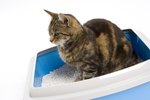
Rats are friendly, sociable pets that don’t ask a lot of their owners, but they do require a clean cage if they are to thrive. A rat that lives in soiled quarters quickly becomes dirty at best; if he’s in there too long he is liable to get sick. The buildup of ammonia as waste breaks down can cause your pet to develop problems with his lungs and eyes. Keeping his cage clean is one of the most important steps in pet rat care.
Frequency
It’s important to clean your pet rat’s cage on a regular basis. Take out your pet’s food and water dishes every day, wash them out and disinfect them. Then give your rat fresh food and water. The American Society for the Prevention of Cruelty to Animals recommends that you remove droppings and soiled litter daily and that you give the cage a complete cleaning once a week. Rats that live in small cages, or those that are a bit overcrowded, will need their cages cleaned more frequently.
Washing
Remove everything from your pet rat’s cage. Wash all toys and dishes at the same time you wash the cage. You can use the same soap for everything. Remove and discard or compost all of the old litter. Place the empty cage in the bathtub or another location where you can easily wash it out. If anything is stuck to the cage, soak it until the matter comes loose. Use disinfectant hand soap or dish soap and warm water to wash the cage thoroughly.
Disinfecting
Once the cage, dishes and toys are clean, disinfect everything with an agent that is nontoxic to pets. Bleach works well, but if it’s too strong it can end up harming your pet. Dilute it with 15 ounces of water to each ounce of bleach. Cover all the surfaces with disinfectant, letting it sit for at least 15 minutes before rinsing well. You should not be able to feel or smell the disinfectant when you are done.
Litter
When the cage is clean, replace the litter on the floor with new, clean litter. Strips or pellets of paper make good bedding. Don’t use cedar or pine shavings, since according to the ASPCA these can harm your pet. Put enough bedding in the bottom of the cage to allow the rat to dig around in it. The Michigan Humane Society suggests using a layer that is at least 2 inches deep. This serves the dual purpose of absorbing waste and providing plenty of material for burrowing.
References
Photo Credits
-
Jupiterimages/Photos.com/Getty Images




